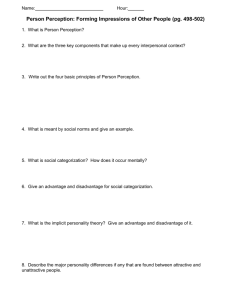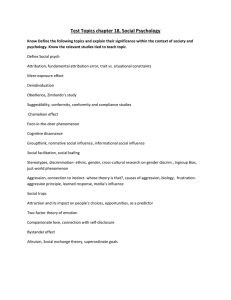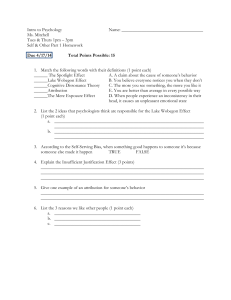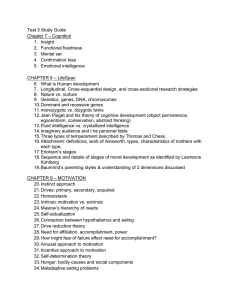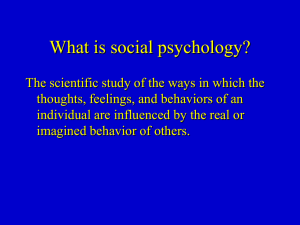AP Psychology: Social Psychology & Attribution Theory
advertisement
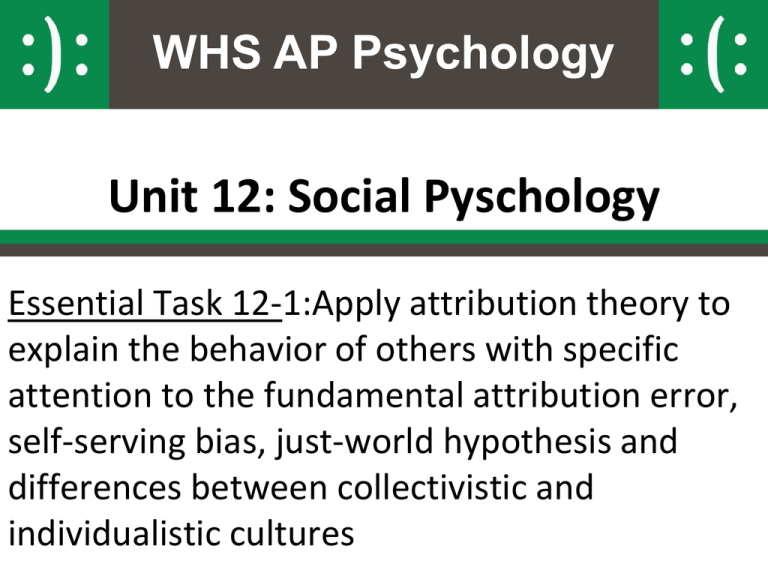
WHS AP Psychology Unit 12: Social Pyschology Essential Task 12-1:Apply attribution theory to explain the behavior of others with specific attention to the fundamental attribution error, self-serving bias, just-world hypothesis and differences between collectivistic and individualistic cultures Fundamental Attribution Error Self-Serving Bias Attribution Individualistic vs. Collectivistic Culture Cognitive Dissonance Attitudes and Persuasion Routes to Persuasion We are here Just-World Hypothesis Unit 12: Social Psychology Impact of Others on You Conformity Schema Attraction InGroup/OutGroup Group Behavior Compliance Group Polarization Group Think Social Psychology • The scientific study of the ways in which the thoughts, feelings, and behaviors of one individual are influenced by the real, imagined, or inferred behavior or characteristics of other people • Today’s class: – How you think about people – How you explain their behavior – Why you like them Social Cognition: How you think about people? • Impression Formation – how do you construct your social cognition? – Primacy effect • Early information about someone weighs more than later information in forming impressions • We are “cognitive misers” – Self-fulfilling prophecy • A person’s expectations about another elicits behavior from the other person that confirms the expectations • “Hostile” partners continued to be more hostile • Randomly identified “bloomers” made greater gains – Schemata – Stereotypes Impression Formation • Schemata – Ready-made categories – Allow us to make inferences about others (good for cognitive misers) – Also plays a major role in how we interpret and remember information – We will remember characteristics of our schema that weren’t there Impression Formation • Stereotypes – A set of characteristics believed to be shared by all members of a social category – It is usually unfair – Most often applied to sex, race, occupation, physical appearance, place of residence, membership in a group or organization – Can become the basis for self-fulfilling prophecies Self-fulfilling prophecy • (Snyder, Tanke & Berscheid, 1977) • Attractiveness Stereotype – sociability and socially savy • Men received “background” information about a woman they were about to talk with on a phone, info included a photo. Women received same info, but no photo. • IV: Photo of woman either attractive or unattractive • DVs: 1) Men’s expectations about the woman 2) Observers’ ratings of the woman’s behavior • Results: When men expected that the woman was attractive, she was judged as friendly, warm, and more animated than when men believed they were talking with an unattractive woman. (self-fulfilling prophecy) Attribution: Why did he do that? • Attribution Theory: tries to explain how people make judgments about the causes of other people’s behavior • Three criteria used to judge behavior – Distinctiveness: Is this how the person treats everyone or are you different? – Consistency: Has the person always treated you this way or is this different? – Consensus: Do other people do this same thing or is this really different? Attribution: Why did he do that? • Bob walks past you without saying hi. – Distinctiveness: Your explanation as to why Bob did this will be different if he does this to everyone in the hall or just you – Consistency: Your explanation as to why Bob did this will be different if he always says hi to you or if you don’t really know each other. – Consensus: Whether you’re in New York vs. a college of 600 will change how you explain Bob’s behavior. Biases in Attribution: The errors to which your guesses will succumb • Actor-Observer Effect: attribute actions of others to internal factors and the actions of yourself to external factors – Fundamental attribution error: the tendency to overemphasize personal causes for others’ behavior and underemphasize personal causes for our own behavior • Defensive attribution – Self-Serving Bias: Tendency to attribute our successes to our own efforts and our failures to external factors – Just-world hypothesis: Assumption bad things happen to bad people and good things happen to good people • Attribution across cultures varies dramatically Effects of Attribution How we explain someone’s behavior affects how we react to it. Collectivistic vs. Individualistic


